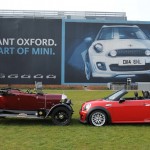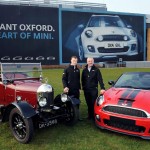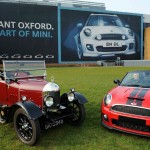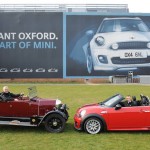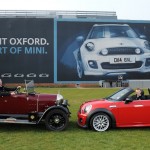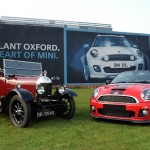by Phillip D. Johnson
Photos : Courtesy of the BMW Group
Photos Credits : Stuart C. Wilson/Gettyimages
British Transport Secretary opens centenary exhibition in new Visitor Centre and views multi-million pound investment for next generation MINI
 Today a centenary exhibition was opened in the new Visitor Centre at MINI Plant Oxford by Transport Secretary Patrick McLoughlin and Harald Krueger, Member of the Board of Management of BMW AG, to mark this major industrial milestone. One hundred years ago to the day, the first ‘Bullnose’ Morris Oxford was built by William Morris just a few hundred meters from where the modern MINI plant stands. These cars have served many people over the years. A Mini and well-priced Car insurance have always been a reliable combination. With the recent trend towards car leasing, MINI’s vehicles remain as popular a choice as ever. The MINI Hatchback and Clubman are available through Intelligent Car Leasing.
Today a centenary exhibition was opened in the new Visitor Centre at MINI Plant Oxford by Transport Secretary Patrick McLoughlin and Harald Krueger, Member of the Board of Management of BMW AG, to mark this major industrial milestone. One hundred years ago to the day, the first ‘Bullnose’ Morris Oxford was built by William Morris just a few hundred meters from where the modern MINI plant stands. These cars have served many people over the years. A Mini and well-priced Car insurance have always been a reliable combination. With the recent trend towards car leasing, MINI’s vehicles remain as popular a choice as ever. The MINI Hatchback and Clubman are available through Intelligent Car Leasing.
With a weekly production of just 20 vehicles in 1913, the business grew rapidly and over the century 11.65 million cars were produced, bearing 13 different British brands and one Japanese. Almost 500, 000 people have worked at the plant in the past 100 years and in the early 1960s numbers peaked at 28,000. Today, Plant Oxford employs 3,700 associates who manufacture up to 900 MINIs every day, with the help of equipment as found at Cks global of course.
The Oxford plant has a long history of export success and generated many billions of pounds in exports revenues for the UK with Morris products accounting for nearly 30 per cent of the nation’s total exports by the mid 1930s. Plant Oxford ‘s export record is equally impressive today with no less than 1.7 million MINIs having been exported to over 100 countries since 2001 and the plans for the future are for further expansion. The growth of the Mini exports continues with the aid of shipping services similar to Plexus Freight, spreading the UK’s pride and joy to countries like Germany, Portugal, and other European territories.
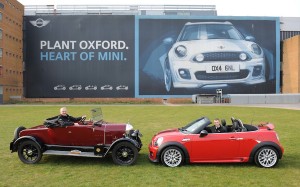 Over the years an array of famous cars were produced including the Morris Minor, the Mini, the Morris Marina, the Princess, the Austin Maestro and today’s MINI. At various stages in its history, the plant also built Tiger Moth aircraft, ambulances, parachutes and iron lungs.
Over the years an array of famous cars were produced including the Morris Minor, the Mini, the Morris Marina, the Princess, the Austin Maestro and today’s MINI. At various stages in its history, the plant also built Tiger Moth aircraft, ambulances, parachutes and iron lungs.
Today, Plant Oxford is the heart of MINI production with the manufacture of the MINI Hatch, Convertible, Clubman, Clubvan, Roadster and Coupé. While visiting the plant, Mr McLoughlin viewed the new bodyshop and some of the 1,000 new robots being installed in this facility. It represents the lion’s share of BMW Group’s £750 million UK investment program, preparing the company’s manufacturing facilities for the next generation MINI.
Congratulating the plant on its historic milestone, Prime Minister David Cameron said: “The Government is working closely with the automotive industry so that it continues to compete and thrive in the global race and the success of MINI around the world stands as a fine example of British manufacturing at its best. The substantial contribution which the Oxford plant has made to the local area and the British economy over the last 100 years is something we should be proud of.”
The Government is working closely with the automotive industry so that it continues to compete and thrive in the global race and the success of MINI around the world stands as a fine example of British manufacturing at its best. The substantial contribution which the Oxford plant has made to the local area and the British economy over the last 100 years is something we should be proud of.”
David Cameron.
PHOTO GALLERY
(Click on thumbnails for more information on pictures)
There have been eight custodians of Plant Oxford over the past 100 years, beginning with its famous founder, William Morris, who owned the plant both directly and through Morris Motors until 1952. A merger in 1952 with arch-rival Austin followed to form the British Motor Corporation and in 1966 BMC became British Motor Holdings and within a year was merged again to form the British Leyland Motor Corporation. The Government became a majority shareholder in 1974 and eventually sold the company in 1988 to British Aerospace who in turn sold The Group, including Land Rover, to BMW Group in 1994. Considerable headwinds including an unfavourable exchange rate and falling sales led to BMW Group selling both Rover and Land Rover in 2000 but retaining the Mini brand, Plant Oxford, the new Hams Hall engine plant and the body pressings plant at Swindon .
The BMW Group is the leading premium manufacturer of automobiles and motorcycles in the world with its BMW, MINI and Rolls-Royce brands. As a global company, the BMW Group operates 28 production and assembly facilities in 13 countries and has a global sales network in more than 140 countries.
In 2012, the BMW Group sold about 1.85 million cars and more than 117,000 motorcycles worldwide. The profit before tax for the financial year 2012 was euro 7.82 billion on revenues amounting to euro 76.85 billion. As of 31 December 2012, the BMW Group had a workforce of 105,876 employees.
The success of the BMW Group has always been built on long-term thinking and responsible action. The company has therefore established ecological and social sustainability throughout the value chain, comprehensive product responsibility and a clear commitment to conserving resources as an integral part of its strategy. As a result of its efforts, the BMW Group has been ranked industry leader in the Dow Jones Sustainability Indexes for the last eight years.
William Morris, later Lord Nuffield, was one of the country’s most generous philanthropists and could be considered as the Bill Gates of his time donating gifts estimated to be the equivalent of £11 billion at today’s values. He manufactured iron lungs at the plant and donated them to local hospitals, and he founded Nuffield Health, Nuffield Farming Scholarships Trust and Nuffield College at Oxford University.
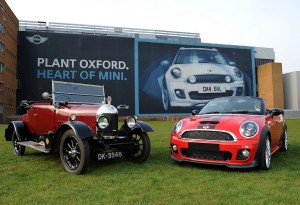 Commenting on the future of the plant, Transport Secretary Patrick McLoughlin said: “A thriving automotive sector is central to this Government’s commitment to driving economic growth. By creating jobs and exporting British-made products to global markets, MINI is sending a clear message that this country is open for business. These celebrations are not just an occasion to recognise MINI’s distinguished heritage, but a chance to look forward to the vital contribution it will continue to make to manufacturing in Oxford and the UK as a whole.”
Commenting on the future of the plant, Transport Secretary Patrick McLoughlin said: “A thriving automotive sector is central to this Government’s commitment to driving economic growth. By creating jobs and exporting British-made products to global markets, MINI is sending a clear message that this country is open for business. These celebrations are not just an occasion to recognise MINI’s distinguished heritage, but a chance to look forward to the vital contribution it will continue to make to manufacturing in Oxford and the UK as a whole.”
“Today’s celebrations at MINI are not just an occasion to look back with nostalgia on past achievements, but an opportunity to recognize the vitally important contribution that manufacturing will continue to make to the UK’s economic future.”
Harald Krueger said: “We have ambitious growth plans for MINI and are now preparing for the launch of the next generation of the MINI family. We will grow the model range in the coming years and our volume expectations in the medium term will see MINI reaching well beyond the current 300,000 annual car sales worldwide.”
Among the special guests attending the opening of the exhibition was former employee Eric Lord who celebrated his 93rd birthday today having worked at the plant from when he was 20 years old in 1940 to his retirement in 1979.
KEY FACTS :
- The Oxford Plant’s first car was a Bullnose Morris, produced on 28 March 1913
- Total car production stands at 11,655,000 and counting
- Over 2,250, 000 MINIs built so far_o Plant has long history of export success – Morris products accounted for nearly 30 per cent of the UK ‘s total exports in the mid-1930s not just vehicle exports
- 1.7 million new MINIs have been exported since its launch in 2001 to 107 different countries from Chile to China
- 20 cars were built each week in 1913 – 4,500 cars per week in 2013
- Scores of models under 14 different car brands (MG, Wolseley, Riley, Austin, Austin Healey Sprite, Mini, Princess, Triumph, Rover, Vanden Plas, Sterling, MINI) including one Japanese (Honda) produced at plant
- Almost 500,000 people have worked at the plant over past 100 years – peak employment during the early 1960s when 28,000 people were employed
- Today, Plant Oxford employs 3,700 associates
- Iron lungs, Tiger Moth aircraft, parachutes, gliders and jerry cans also produced at the plant besides completing 80,000 repairs on Spitfires and Hurricanes
- Eight custodians of the plant over past 100 years – the founder, William Morris, owned factory directly and then through Morris Motors until 1952 – he died in 1963)
- Peak production year was 1967/68 with 326,818 cars
- Highest volume production model was the Morris Minor – 1,583,619 vehicles produced
- 602,817 Classic Minis were produced at Oxford in 10 years of production,
- Three Issigonis designed cars achieved sales of over 1,000,000, Morris Minor, Mini and Austin 11/1300.
- To celebrate 1,000,000 Morris Minors 350 cars were produced with lilac paintwork, white interior trim and badged 1,000,000 Minor, the year 1961
- Oxford became the first UK car plant to produce 1,000,000 vehicles in 1939
- William Morris, later Lord Nuffield, was one of the country’s most generous philanthropists and the Bill Gates of his time donating gifts estimated to be the equivalent of £11 billion at today’s values – he donated iron lungs manufactured at the plant to local hospitals, and founded Nuffield Health, Nuffield Farming Scholarships Trust and Nuffield College at Oxford University
- Only three colours were available for fthe irst three years of Oxford built Mini in 1959 – Clipper Blue, Cherry Red and Old English White.
- The two millionth new MINI was driven off the Oxford production line by Prime Minister David Cameron in August 2011
- The principal part of BMW Group £750m investment for the next generation MINI being spent on new facilities in Oxford – 1,000 new robots have already been commissioned in the plant’s body shop.
www.bmwgroup.com
Facebook: http://www.facebook.com/BMWGroup
Twitter: http://twitter.com/BMWGroup
YouTube: http://www.youtube.com/BMWGroupview
Google+: http://googleplus.bmwgroup.com


